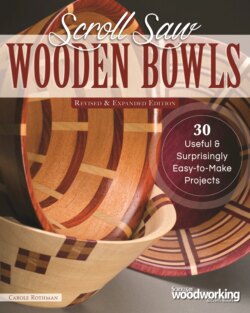Читать книгу Scroll Saw Wooden Bowls, Revised & Expanded Edition - Carole Rothman - Страница 45
Applying a shellac or lacquer finish
ОглавлениеAlthough I’ve tried various finishes for my bowls, I find that the simplest and most versatile is shellac, brushed on or sprayed. I use it either by itself or as a base for sprayed lacquer. I start with a thin sealer coat of dewaxed shellac to seal the wood and reveal any remaining glue spots. Since the shellac raises the grain, I smooth the surface with 320-grit sandpaper, or by buffing the bowl with a small, well-worn 320-grit sanding mop. Its small size lets me access both interior and exterior surfaces, and unlike sandpaper it leaves no particles. When I do need to remove particles, I find it easiest to use a shop vacuum and nozzle that’s covered with a sock to prevent scratches. For shellac-only finishes, I apply several more coats, rubbing down the surface with 0000 steel wool after each application, if needed. If I’m using lacquer on top of the shellac, I’ll usually apply a second coat of shellac, rub it down, and follow it with several coats of spray lacquer, rubbing down each coat as with the shellac. To prevent drips or sags when spraying, elevate the bowl, hold the can upright, and spray with sweeping strokes. To spray the outside of a bowl with steep sides, invert it over a spray can or other tall, stable object.
It’s now time to move on to Chapter 2, which starts with a step-by-step guide to the creation of the Basic Bowl.
